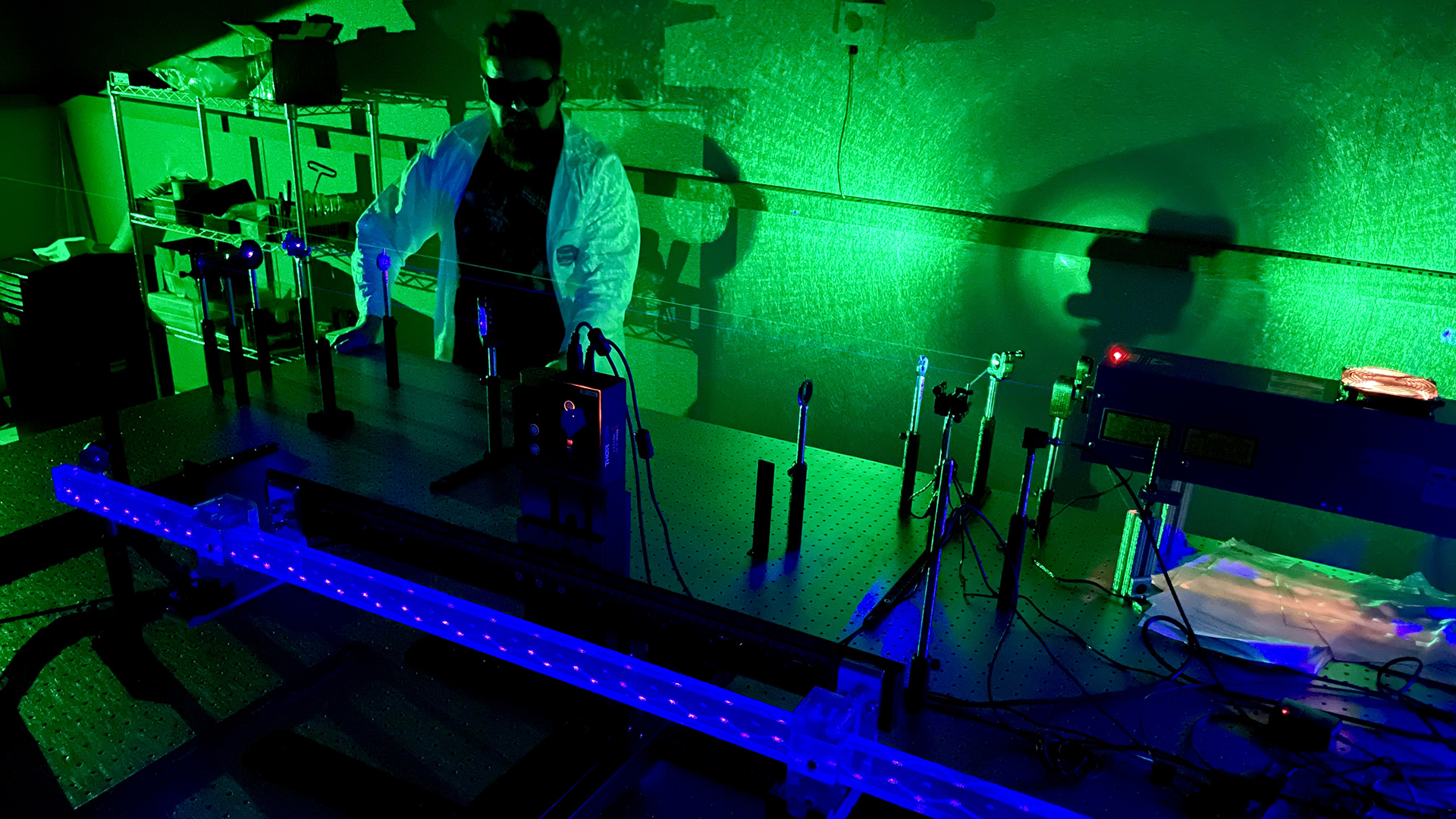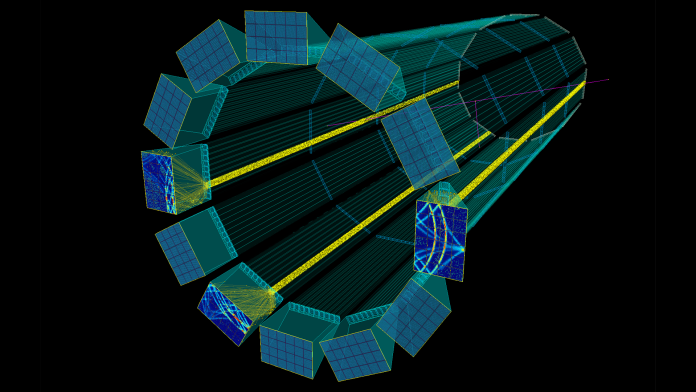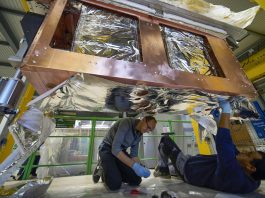Dr Grzegorz Kalicy is leading developments in cutting-edge DIRC technology to advance particle physics, which will play a key role in the future Electron-Ion Collider.
In the world of particle physics, identifying the vast array of particles produced during high-energy collisions is essential for understanding the Universe’s fundamental structure and governing forces. One of the new and important tools for this task is the DIRC (Detection of Internally Reflected Cherenkov light) detector, which measures the faint light emitted by particles as they pass through. DIRC technology has evolved significantly since its first implementation in the BaBar experiment at Stanford Linear Accelerator Center (SLAC), and today the challenge is to push it even further.
At the forefront of this advancement is Dr Greg Kalicy, an Associate Professor at the Catholic University of America in Washington DC, who is driving and co-ordinating an international effort to develop the next-generation high-performance DIRC (hpDIRC) detector. This detector will play a critical role in the Electron-Ion Collider (EIC) – a particle accelerator experiment poised to explore the fundamental structure of matter. With his experience in the PANDA Barrel DIRC group and the GlueX DIRC group, Dr Kalicy has been pivotal in advancing DIRC technology to meet the extreme demands of modern experiments.
The DIRC Principle: A unique solution for particle identification
DIRC detectors work by capturing and analysing Cherenkov light, which is emitted with unique properties when charged particles move through a medium faster than light can travel in that medium. The light is trapped within specially designed quartz bars and guided, much like in optical fibres, through internal reflections. This allows the Cherenkov light to travel over long distances with minimal loss, eventually reaching an expansion volume where it is projected onto an array of pixelated photodetectors for imaging. By carefully reconstructing the emission angle and speed of this light from convoluted images, scientists can determine the particle’s identity.
This technology will be crucial in particle accelerator experiments like the EIC, where millions of particles are produced in every collision, creating a complex mix of electrons, protons, pions, kaons, and other subatomic particles. Identifying these particles accurately is essential for understanding the underlying physics. The beauty of DIRC technology lies in its compactness and ability to function within the magnetic fields typically found in such experiments. Its thin, space-saving design makes it an ideal solution for the the barrel section of detectors, where space is limited. This is in contrast to RICH (Ring Imaging Cherenkov) detectors, which use gaseous or liquid radiators and require far more space to perform particle identification.
However, DIRC detectors face a formidable challenge: they must register and reconstruct data from only a small amount of single photons of light, emitted by the particles. This light is not only faint but must be imaged and captured with extreme precision to ensure the correct particle is identified. Improving this process has been a central goal for Dr Kalicy and his team as they work to develop the hpDIRC detector.
The high-performance DIRC: A step forward
The high-performance DIRC (hpDIRC) represents a dramatic leap from the original BaBar DIRC detector, building on 13 years of research and development. The project began with a bold question: Could a DIRC detector be developed that would double the performance of the state-of-the-art technology at the time? This ambitious goal required a complete rethinking of several components, including the optical system, sensors, and electronics.

Dr Kalicy and Dr Jochan Schwiening from GSI have been instrumental in leading the hpDIRC’s development across multiple institutions, introducing crucial innovations that have significantly advanced the technology. One of the most significant breakthroughs has been the development of a unique three-layer lens system, designed to focus the Cherenkov light with unprecedented accuracy. This innovation came out of early collaboration with the PANDA Barrel DIRC group, where the need for an advanced lens system became apparent. The challenge was to prevent photon loss while focusing with high precision the light travelling through the quartz bars – a notoriously difficult task given that the standard lenses required air gaps,
which would result in dramatic light loss. The solution came in the form of a three-layer lens, which uses high-refractive-index materials such as crown glass or sapphire, sandwiched between two layers of quartz. This design eliminates photon loss while significantly improving focusing accuracy. Sapphire, in particular, has emerged as the leading candidate for the middle layer due to its radiation hardness and transparency to low-wavelength light, making it ideal for the high-radiation environments of particle accelerators.
Achieving unprecedented precision
In particle experiments, timing is everything. To give you an idea of the level of precision involved, the readout chain of the hpDIRC detector needs to be faster than 100 picoseconds (ps). Imagine timing a runner in a race. Now, imagine timing that runner so precisely that you are measuring intervals a billion times shorter than a single blink of an eye. That’s the kind of accuracy needed to distinguish particles in an EIC experiment. Such precision allows the hpDIRC to ‘see’ particles with incredible clarity, enabling scientists to separate particles that otherwise look very similar. This is particularly important in the EIC, where distinguishing between particles like kaons and pions – both of which play key roles in understanding the strong nuclear force – can unlock new insights into the fundamental structure of matter.
The process of designing and validating hpDIRC components has been extensive, requiring years of simulations, prototyping, and testing. Dr Roman Dzhygadlo, another GSI scientist, has brought his expertise in software development to the table. Dr Dzhygadlo has performed what can only be described as ‘magic’ with the array of software tools he has developed and adapted for various DIRC detectors, including the hpDIRC. His software enables precise simulations, crucial for optimising the design and performance of the detector. Dr Kalicy has overseen the construction of specialised testing setups, such as a laser-based system that immerses the lens in mineral oil to simulate its environment inside the detector. These tests have confirmed the extraordinary performance of the lens system, ensuring that it meets the stringent requirements for the EIC.
The following step involved validating the hpDIRC’s performance in real-world conditions. Test beam campaigns, conducted in collaboration with the PANDA Barrel DIRC group, have demonstrated that the hpDIRC can achieve the performance levels predicted by simulation. These tests provided the confidence needed to move the project into its final phase: being accepted as one of the technologies for the ePIC detector and building a full system prototype.

Preparing for full-scale construction
Currently, the team is focused on two major hardware projects before the hpDIRC is ready for full-scale construction. The first is the development of a full system prototype, which will allow scientists to test a complete slice of the detector in conditions that closely mimic those of the EIC. Given the limited access to particle beams for testing, the hpDIRC team, led by Dr Jaydeep Datta and Nathan Shankman from Stony Brook University, developed a ‘Cosmic Ray Telescope.’ This setup utilises naturally occurring cosmic muons to simulate the conditions the detector will experience in the accelerator.
The second priority project, led by Dr Kalicy and Andrew Lumanog from Jefferson Lab, involves the reuse of legacy quartz bars from the BaBar DIRC detector. If successful, this effort could save $15m for the EIC.

These bars, stored in bar boxes at SLAC since 2010, were recently moved to JLab where they will be carefully disassembled and tested to ensure they meet the unprecedented optical quality standards required for the hpDIRC. A custom-built, six-metre-long CNC machine has been constructed
to open the aluminum cases containing the bars and separate the glued segments. Once the bars are extracted, they will be cleaned and measured with nanometre precision for quality in a specialised laser lab built for this purpose at Jefferson Lab. A sheet of paper is approximately 100,000nm thick, while the hpDIRC bars must be smooth to an accuracy of 0.5nm, which is roughly the space needed to fit four hydrogen atoms.
Looking ahead: The future of DIRC technology
With the hpDIRC in its final stages of development, Dr Kalicy and the rest of the hpDIRC team are already looking to the future. The next phase of innovation is the development of the eXtreme-performance DIRC (xpDIRC), which aims to push the limits of particle identification even further. Combining novel geometries with next-generation components, the xpDIRC aims to provide even better performance, ensuring that future particle accelerators are equipped with the most advanced technology available.
DIRC technology’s evolution from the BaBar experiment to the hpDIRC is a testament to the power of innovation in particle physics. The development of the hpDIRC has not only advanced the state of the art but also opened the door to new possibilities in particle identification, paving the way for the next generation of scientific discovery at the Electron-Ion Collider and beyond.
Please note, this article will also appear in the 20th edition of our quarterly publication.





